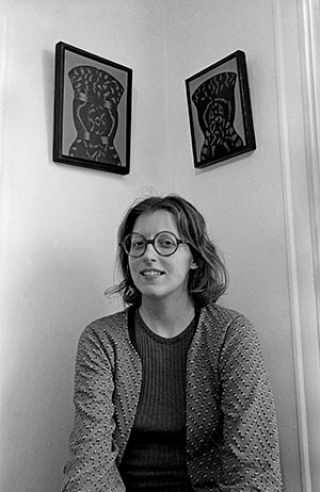Born 1945, Fort Campbell, Kentucky
Died 1995, Chicago, Illinois
Hair, fur, stilettos, satin, lace, and corsets embellish and constrict female bodies in the sensuous, sinister paintings of Christina Ramberg. Shown from the neck down or from behind, Ramberg’s women remain anonymous. Like the impersonal, mechanistic figures painted by Fernand Léger and Richard Lindner, their flesh is as hard and smooth as a mannequin’s. The female form is particularly objectlike in Ramberg’s small-scale, multipanel works such as Lola La Lure, in which body fragments—an ornate coiffure, a foot encased in a leopard-print pump, and hips compressed by a lacy girdle—are isolated like precious curios within separately framed canvases painted to resemble mirrored display cases. The individual panels of this work also evoke the comic strip format, an association heightened by Ramberg’s use of jagged, comic-style highlights to render the sheen of hair and satiny fabric. In later, more abstract works, hourglass figures metamorphose into urns, chairs, and inanimate objects. Strung (For Bombois) shows a humanoid wooden armature mysteriously wrapped in bandages and sprouting tufts of hair, an unsettling juxtaposition in the vein of Meret Oppenheim’s fur-lined teacup.
Following in the footsteps of the Hairy Who, Ramberg banded together with fellow students at the School of the Art Institute of Chicago—including husband Philip Hanson, Roger Brown, and Eleanor Dube—for a series of group shows at the Hyde Park Art Center in 1968 and 1969 entitled False Image. Art Institute professor Ray Yoshida introduced her, Hanson, and Brown to Chicago’s Maxwell Street flea market and cultivated in each of them a collector’s mentality. Ramberg accumulated some 350 dolls, which she displayed on the walls of her apartment; she kept scrapbooks filled with clippings from comics, vintage advertisements, and medical illustrations. Yoshida’s enthusiasm for outsider art also made an impact on her. In 1974 she traveled to Europe to see the collections of Jean Dubuffet and Hans Prinzhorn and was struck by the similarities between August Natterer’s skirt transformations and her own work. In naming one painting after French naïve artist Camille Bombois, she was likely expressing her affinity with his fixation on voluptuous females. As Ramberg once reflected, “My aim is to make from my obsessions and ideas the strongest, most coherent visual statement possible.”
Antonia Pocock
Adrian, Dennis, and Carol Becker. Christina Ramberg: A Retrospective, 1968–1988. Chicago: The Renaissance Society at the University of Chicago, 1988.
Porter, Jenelle. Christina Ramberg. Boston: Institute of Contemporary Art, 2013.
